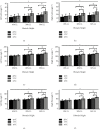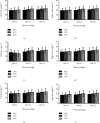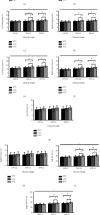Increased Asymmetry of Lower Limbs and Leading Joint Angles during Crossing Obstacles in Healthy Male with Cold Exposure
- PMID: 36284893
- PMCID: PMC9588374
- DOI: 10.1155/2022/6421611
Increased Asymmetry of Lower Limbs and Leading Joint Angles during Crossing Obstacles in Healthy Male with Cold Exposure
Abstract
Lower ambient temperatures impair neuromuscular function and balance. However, whether lower ambient temperatures could alter joint angles and symmetry of lower limbs during crossing obstacles in males still remains unknown. Therefore, we investigated whether there is reduction of ambient temperature (20°C; 15°C; 10°C) on lower limbs joint angles and symmetry when crossing obstacles in males. On three different occasions, eighteen male participants underwent 30 min exposure to three different environmental temperatures (10°C, 15°C, and 20°C), which was followed by the obstacle crossing test at 10%, 20%, and 30% of the participant leg length. In each trial, we assessed joint angles and symmetry of lower limbs when crossing obstacles at 10%, 20%, and 30% of the participants' leg length. The results showed that leading limb maximum joint angles were greater in 10°C than in 15°C and 20°C when leading limb crossed obstacle heights of 20% and 30% leg length (p < 0.05). Trailing limb maximum joint angles were not different (p > 0.05). Lower limb asymmetry increased when participants crossed obstacle heights of 20% and 30% leg length at 10°C (p < 0.05). This study concluded that in male participants, cold exposure can increase lower limb asymmetry to increase falling risk when crossing obstacles. Also, the increased leading limb joint angles and constant trailing limb joint angles increase safety during crossing obstacles.
Copyright © 2022 Shun Yao et al.
Conflict of interest statement
All authors declare that they have no conflict of interest regarding the contents of this article.
Figures




Similar articles
-
Effect of hyperthermia on simulated muscle activation in female when crossing obstacle.Sci Rep. 2024 May 9;14(1):10635. doi: 10.1038/s41598-024-61536-y. Sci Rep. 2024. PMID: 38724575 Free PMC article.
-
The effect of transcranial direct current stimulation on bilateral asymmetry and joint angles of the lower limb for females when crossing obstacles.BMC Sports Sci Med Rehabil. 2023 Dec 21;15(1):176. doi: 10.1186/s13102-023-00793-2. BMC Sports Sci Med Rehabil. 2023. PMID: 38129892 Free PMC article.
-
Comparisons of the inter-joint coordination between leading and trailing limbs when crossing obstacles of different heights.Gait Posture. 2008 Feb;27(2):309-15. doi: 10.1016/j.gaitpost.2007.04.007. Epub 2007 May 17. Gait Posture. 2008. PMID: 17499992
-
Inter-joint coordination during obstacle crossing in people with diabetic neuropathy.J Biomech. 2020 May 22;105:109765. doi: 10.1016/j.jbiomech.2020.109765. Epub 2020 Apr 2. J Biomech. 2020. PMID: 32307183
-
Kinematic strategies for obstacle-crossing in older adults with mild cognitive impairment.Front Aging Neurosci. 2022 Dec 13;14:950411. doi: 10.3389/fnagi.2022.950411. eCollection 2022. Front Aging Neurosci. 2022. PMID: 36583190 Free PMC article.
Cited by
-
Effect of hyperthermia on simulated muscle activation in female when crossing obstacle.Sci Rep. 2024 May 9;14(1):10635. doi: 10.1038/s41598-024-61536-y. Sci Rep. 2024. PMID: 38724575 Free PMC article.
References
LinkOut - more resources
Full Text Sources

